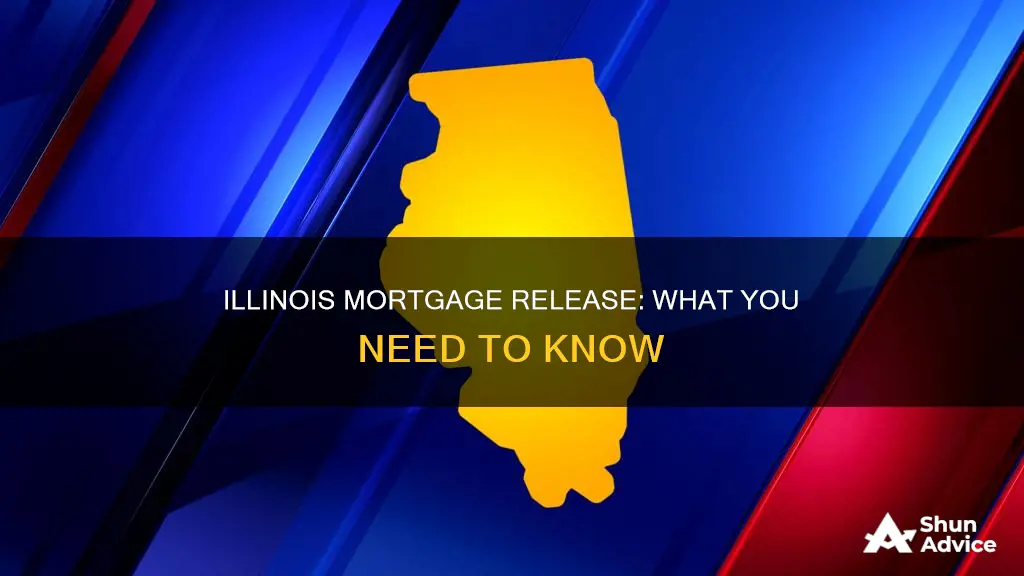
In Illinois, there are two types of release of mortgage forms: full and partial. A full release form is used when the borrower has completely paid off the mortgage and the lender releases all rights to the property. A partial release form is used when a portion of the mortgage has been paid and the lender releases its claim on a specific portion of the property. There are fillable release of mortgage forms available online for Illinois, which can be filled, signed, and sent from any device.
Releasing a Mortgage in Illinois
| Characteristics | Values |
|---|---|
| Types of Release of Mortgage Forms | Full Release, Partial Release |
| Full Release Form | Used when the borrower has completely paid off the mortgage and the lender releases all rights to the property |
| Partial Release Form | Used when a portion of the mortgage has been paid and the lender releases its claim on a specific portion of the property |
| Where to obtain the appropriate release of mortgage form | County recorder's office or an authorized legal forms provider |
| Information to include in the form | Borrower's name, lender's name, property address, type of release, details of the mortgage being released, additional information such as the mortgage document number or recording information |
| Submission of the form | Submit the completed form to the county recorder's office along with any applicable fees |
| Time limit for filing the release | The lender generally has 30 days to file the release after the payment of the debt secured by the mortgage |
| Requirements for the release | The release must be in writing and may be acknowledged or proved in the same manner as deeds for the conveyance of land |
| Delivery of the release | If the release is delivered to the borrower, it must have imprinted on its face in bold letters: "FOR THE PROTECTION OF THE OWNER, THIS RELEASE SHALL BE FILED WITH THE RECORDER OR THE REGISTRAR OF TITLES IN WHOSE OFFICE THE MORTGAGE OR DEED OF TRUST WAS FILED" |
What You'll Learn

Full and partial release of mortgage forms
In Illinois, there are two commonly used types of release of mortgage forms: Full Release and Partial Release. These forms can be obtained from the county recorder's office or an authorized legal forms provider.
Full Release
A full release form is used when the borrower has completely paid off the mortgage and the lender releases all rights to the property.
Partial Release
A partial release form is used when a portion of the mortgage has been paid, and the lender releases their claim on a specific portion of the property, such as a single lot in a larger tract.
To avoid penalties, the mortgagee/lender has 30 days to file the release after the payment of the debt secured by the mortgage. The release must be delivered to the mortgagor or grantor with the following statement imprinted in bold letters at least 1/4 inch in height: "FOR THE PROTECTION OF THE OWNER, THIS RELEASE SHALL BE FILED WITH THE RECORDER OR THE REGISTRAR OF TITLES IN WHOSE OFFICE THE MORTGAGE OR DEED OF TRUST WAS FILED".
The release of mortgage form requires the following information:
- Borrower's name
- Lender's name
- Property address
- Type of release (full or partial)
- Details of the mortgage being released
- Any additional information, such as the mortgage document number or recording information
- Signature and date
Once completed, the form should be submitted to the county recorder's office, along with any applicable fees.
Missouri Mortgage Recording: A Step-by-Step Guide
You may want to see also

Avoiding penalties
If you are facing mortgage foreclosure in Illinois, there are several steps you can take to avoid penalties. Here are some key points to consider:
Loss Mitigation Application
Submit a loss mitigation application to your mortgage servicer, which is the company that takes your mortgage payments. This application allows you to explore options to avoid foreclosure. It is important to submit a complete application with all the required information and documents. You can also seek free assistance from a HUD-Certified Housing Counselor when preparing your application.
Timing of Application
The timing of submitting your loss mitigation application is crucial. Ideally, you should submit it at least 90 days before a Sheriff's sale. If you submit it at least 37 days before the sale, your mortgage servicer cannot ask for a foreclosure judgment or conduct the Sheriff's sale. However, submitting the application earlier gives you more time to explore options and negotiate with your lender.
Cooperation and Communication
It is essential to cooperate with your mortgage servicer and provide any additional documents or information they request. Keep open lines of communication with your servicer and work with them in good faith to find a solution. They are required to evaluate all loss mitigation options available to you and offer you the applicable ones.
Legal Assistance
Consider seeking legal assistance from a foreclosure defense attorney or an Illinois foreclosure lawyer. They can review your specific circumstances and determine the best strategies to advocate for you. They may be able to negotiate with your lender, apply for relief to block the foreclosure, or explore other legal avenues to help you keep your home.
Avoid Mortgage Fraud
Mortgage fraud is a serious felony under Illinois and federal law, with severe penalties, including fines of up to $1 million or more and up to 30 years in jail. Ensure that you provide accurate and honest information to your lender and legal representatives throughout the process.
Remember, facing foreclosure can be a challenging situation, but you have rights and options. Taking proactive steps, seeking assistance, and staying engaged in the process can help you avoid penalties and find a positive resolution.

Release of mortgage lien
In Illinois, a release of mortgage form is a legal document signifying that a borrower has fully repaid their mortgage and the lender no longer has any claim on the property. There are two types of release of mortgage forms: a full release and a partial release. A full release is used when the borrower has completely paid off the mortgage and the lender releases all rights to the property. A partial release, on the other hand, is used when only a portion of the mortgage has been paid, and the lender releases its claim on a specific portion of the property, such as a single lot in a larger tract.
To obtain a release of mortgage lien, you must first fill out the appropriate form. These can be obtained from the county recorder's office or an authorised legal forms provider. The form should include the borrower's name, the lender's name, and the property address. It should also specify whether it is a full or partial release and provide details of the mortgage being released, including any relevant document numbers or recording information.
Once the form has been completed, it must be signed and dated by the borrower. The release must then be delivered to the mortgagor or grantor with the following imprinted on its face in bold letters at least 1/4 inch in height: "FOR THE PROTECTION OF THE OWNER, THIS RELEASE SHALL BE FILED WITH THE RECORDER OR THE REGISTRAR OF TITLES IN WHOSE OFFICE THE MORTGAGE OR DEED OF TRUST WAS FILED".
Finally, the completed form should be submitted to the county recorder's office, along with any applicable fees. It is important to note that the lender generally has 30 days to file the release after the payment of the debt secured by the mortgage to avoid penalties.

Obtaining the appropriate release of mortgage form
To obtain the appropriate release of mortgage form in Illinois, you must first select the county where the real estate is located. This is because the specific forms may vary depending on the county. The Illinois Release of Mortgage Package includes the relevant form, guidelines, and a completed example. This form can be used by the current mortgage holder or their representative to release a mortgage that has been paid in full.
It is important to note that, to avoid penalty, the mortgagee/lender (or their executor, administrator, heirs, and assigns) generally has 30 days to file the release after the payment of the debt secured by the mortgage. The release can be acknowledged or proved in the same manner as deeds for the conveyance of land.
If the release is delivered to the mortgagor or grantor, specific wording must be included on the form. This wording should be imprinted in bold letters, at least 1/4 inch in height, and should state: "FOR THE PROTECTION OF THE OWNER, THIS RELEASE SHALL BE FILED WITH THE RECORDER OR THE REGISTRAR OF TITLES IN WHOSE OFFICE THE MORTGAGE OR DEED OF TRUST WAS FILED".
By following these steps and referring to the Illinois Release of Mortgage Package, you can obtain the appropriate release of mortgage form and complete the necessary steps to release a mortgage in Illinois.

Submitting the completed form
Once you have completed the form, you will need to submit it to the county recorder's office. This can be done in person or by post, depending on the county in question. Some counties may also offer an online submission service. Be sure to check with your local county office to confirm the available options and any associated requirements.
Along with the completed form, you will need to submit any applicable fees. These fees may vary depending on the county and the type of release being requested. Again, it is advisable to check with the relevant county office to determine the exact amount owed.
In addition to the form and fees, you may also be required to provide supporting documentation. This could include proof of payment, such as a copy of the cancelled cheque used to pay off the mortgage, or a statement from the lender confirming that the debt has been satisfied. In some cases, additional identification or proof of ownership may be requested.
It is important to note that the release of mortgage form must be submitted within a certain timeframe to avoid penalties. In Illinois, the lender generally has 30 days from the payment of the debt to file the release. This timeframe may vary in other states, so it is always best to review the relevant state laws or consult with a legal professional to ensure compliance with any applicable deadlines.
Finally, once the completed form has been submitted, it is a good idea to follow up with the county recorder's office to confirm receipt and ensure that all necessary information has been provided. This can help prevent any delays in processing and ensure the efficient release of the mortgage lien on the property.
Frequently asked questions
A release of mortgage form is a legal document used to release a mortgage lien on a property. It signifies that the borrower has fully repaid the mortgage and the lender no longer has any claim on the property.
There are two commonly used types of release of mortgage forms in Illinois: Full Release and Partial Release. A Full Release form is used when the borrower has completely paid off the mortgage and the lender releases all rights to the property. A Partial Release form is used when a portion of the mortgage has been paid and the lender releases its claim on a specific portion of the property.
You will need the borrower's name, the lender's name, and the property address. You will also need to specify the type of release (full or partial) and provide details of the mortgage being released, including any relevant document numbers or recording information.
You can obtain a release of mortgage form from the county recorder's office or an authorized legal forms provider.
After filling out the form, you will need to sign and date it. Then, submit the completed form to the county recorder's office along with any applicable fees.







